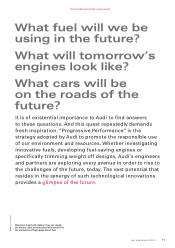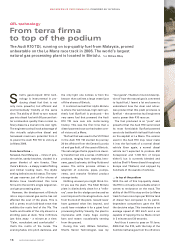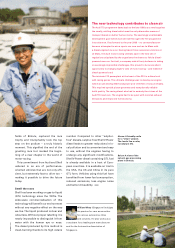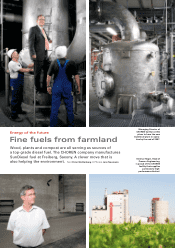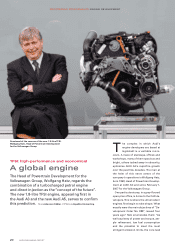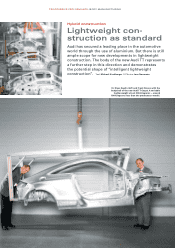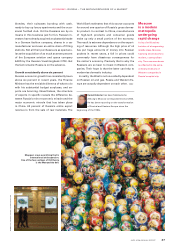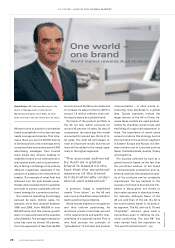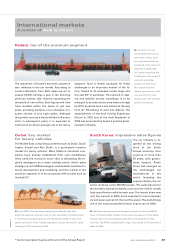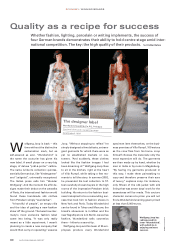Audi 2006 Annual Report Download - page 23
Download and view the complete annual report
Please find page 23 of the 2006 Audi annual report below. You can navigate through the pages in the report by either clicking on the pages listed below, or by using the keyword search tool below to find specific information within the annual report.
The Audi 1.8l 4V TFSI engine
Development codename: 888; displacement:
1,798 cm3; stroke: 84.1 mm; cylinders: 4;
cylinder spacing: 88 mm; crankshaft
bearings: 5; power output: 118 kW (160 bhp);
torque: 250 Nm; average fuel consumption
(on the Audi A3): 7.3 l/100 km;
fuel type
RON: 95/91; emission standard: EU IV;
engine
casing: grey cast iron; engine casing weight:
33 kg.
Despite the additional balancer shaft assembly
and high-pressure injection system,
this
engine is 1 kg lighter than its predecessor.
The engine has to withstand intensive
tests on the engine test bench.
of this new generation was to optimise
costs quite substantially.” This was the
mission of the turbocharged 1.8-litre
engine with direct injection – a principle
with which the 2.0 TFSI is already enjoy-
ing eminent market success.
Wolfgang Hatz is staking out the ter-
rain with the 1.8 TFSI, which is about
to make its debut in the Audi A3* and
the new Audi A5*: “Audi is already the
biggest manufacturer of turbocharged
petrol engines with direct injection. I’ve
been convinced for years that this is the
concept of the future, akin to the TDI in
the domain of diesel engines.”
The engine workshop on the ground
floor is a hall with workbenches and
measuring equipment. Hatz greets the
mechanics with a handshake and heads
for a specimen of the new TFSI. “See
here,” his Baden accent blending in-
congruously with his Bavarian turn of
phrase, “This is the new, virtually no-
maintenance toothed chain for the
camshafts. And here are the balancing
shafts. We have relocated them inside
the crankcase. That cuts costs and pro-
duces more effective mass balancing.
We used grey cast iron for the engine
casing for acoustic reasons, but it still
weighs only 33 kilograms.”
Next port of call: the engine test rigs –
soundproofed chambers containing a
forest of wiring harnesses and exhaust
pipes as thick as your arm. The techni-
cian at the control desk moves up the
control, causing the displays on the
monitor to rush by up to a speed of
6,500 rpm. A glance through the safety-
glass window reveals the manifold
glowing red-hot at a temperature of 950
degrees Celsius. “It develops 118 kW –
that’s 160 bhp – and 250 Nm torque,
from an engine speed of just 1,500
rpm,” comments Hatz. “Our new 888 is a
downsizing concept. It delivers the per-
formance that we were getting from a
six-cylinder engine a couple of years
back, but its fuel consumption is much
lower.”
Newly developed injection system
The low fuel consumption – averaging
7.3 litres per 100 kilometres in the A3 –
is also due in part to the combination of
turbocharging with FSI direct injection.
A watercooled turbocharger forces the
air into the combustion chambers, and
a newly developed injection system in-
jects the fuel at 150 bar. These two tech-
nologies are an ideal match, because
the directly injected petrol cools down
the combustion chambers and allows a
high compression ratio. Audi has al-
ready demonstrated the huge potential
of the TFSI principle with its R8 racing
car on circuits all over the world.
“Yes,” says Hatz, his eyes lighting up,
“we have been helping to plan all these
technologies right from the outset.” The
basic concept of the successful prede-
cessor generation goes back to 1972. It
was constantly refined in an effort to
keep abreast of changing requirements
over this period of 35 years. “But we
eventually reached a point where it was
better to make a clean break with the
past, all things taken into consideration.
And that’s precisely what we did with
our “Global Engine”. An opportunity like
that doesn’t come along very often, with
the entire business costing several hun-
dred million euros.”
The 1.8 TFSI represents a major stra-
tegic advance for Audi on the world’s
markets. It will be built in six different
versions, cover an extensive perform-
ance range and be available in numer-
ous different countries. As well as at
“Modern technology is immensely
enjoyable”, believes Johannes
Köbler (44). The freelance motoring
journalist, who is as much at home
in the print sector as in the world of TV and the
online sector, has been monitoring develop-
ments in the car industry for the past 15 years.
* fuel consumption figures at the end of the Annual Report
Gyo´´r, in Hungary, it will be produced at
the brand-new Volkswagen engine
plant in Dalian, China. “We will ramp up
production to around one million units
a year relatively quickly,” declares Hatz.
“And the engine’s codename 888 is re-
garded as a lucky number in China.”
“Really fun to drive”
A white S3* is standing outside the
building – its TFSI, a two-litre version,
developing 195 kW (265 bhp). “This car
really is fun to drive,” exclaims Hatz,
climbing into the driver’s seat. “0 to 100
in 5.7 seconds! Such compelling per-
formance really turns the heat up on
quite a few six-cylinder engines. I like its
sporty sound, though I think we could
increase it just a touch – we’ll see.”
We roll back into the yard. Hatz climbs
out and enjoys a cigarillo before hurrying
off to his next appointment. All part of
the business of developing even better
engines for an even stronger future.


